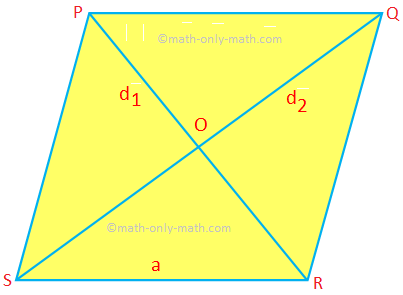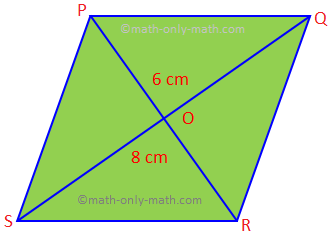Perimeter and Area of Rhombus
Here we will discuss about the perimeter and area of a rhombus and some of its geometrical properties.
Perimeter of a rhombus (P) = 4 × side = 4a
Area of a rhombus (A) = 12 (Product of the diagonals)
= 12 × d1 × d2
Some geometrical properties of a rhombus:
In the rhombus PQRS,
PR ⊥ QS, OP = OR, OQ = OS,
PQ2 = OP2 + OQ2
QR2 = OQ2 + OR2
RS2 = OR2 + OS2
SP2 = OS2 + OP2
Solved Example Problem on Perimeter and Area of Rhombus:
1. The diagonals of a rhombus measure 8 cm and 6 cm. Find the area and the perimeter of the rhombus.
Solution:
In the rhombus PQRS, QS = 8 cm and PR = 6 cm.
Then, area of the rhombus = 12 × d1 × d2
= 12 × QS × PR
= 12 × 8 × 6 cm2
= 24 cm2
Now, OP = 12 PR = 12 × 6 cm = 3 cm and,
OQ = 12 QS = 12 × 8 cm = 4 cm.
Also, ∠POQ = 90°.
So by Pythagoras’ theorem, PQ2 = OP2 + OQ2
= (32 + 42) cm2
= (9 + 16) cm2
= 25 cm2
Therefore, PQ = 5 cm
Therefore, perimeter of a rhombus (P) = 4 × side
= 4 × 5 cm
= 20 cm
From Perimeter and Area of Rhombus to HOME PAGE
Didn't find what you were looking for? Or want to know more information about Math Only Math. Use this Google Search to find what you need.
Recent Articles
-
Vertical Subtraction | Examples | Word Problems| Video |Column Method
Mar 22, 25 05:20 PM
Vertical subtraction of 1-digit number are done by arranging the numbers column wise i.e., one number under the other number. How to subtract 1-digit number vertically? -
Worksheet on 11 Times Table | Printable Multiplication Table | Video
Mar 22, 25 05:08 PM
Worksheet on 11 times table can be printed out. Homeschoolers can also use these multiplication table sheets to practice at home. -
Worksheet on 10 Times Table | Printable Multiplication Table | Video
Mar 21, 25 03:46 PM
Worksheet on 10 times table can be printed out. Homeschoolers can also use these multiplication table sheets to practice at home. -
5th Grade Prime and Composite Numbers | Definitions | Examples | Math
Mar 21, 25 12:18 AM
5th grade prime and composite numbers -
14 Times Table | Read and Write Multiplication Table of 14| Video
Mar 20, 25 04:03 PM
In 14 times table we will learn how to read and write multiplication table of 14. We read fourteen times table as:One time fourteen is 14 Two times fourteen are 28 Three times fourteen are 42







New! Comments
Have your say about what you just read! Leave me a comment in the box below. Ask a Question or Answer a Question.